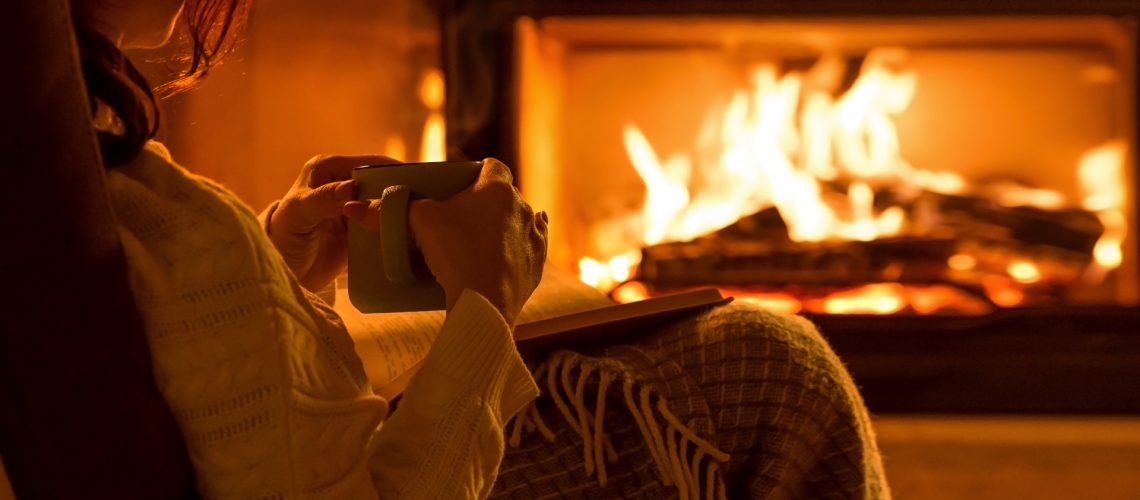It’s one of the great unsung American Pastimes. Lounging in front of a roaring flame with a blanket, a cup of something tasty, a good book, and, hopefully, someone to snuggle up to. If you have a traditional fireplace or wood stove in your home, you’ve probably been looking forward to the colder months just for this! And now that winter is here, it’s finally time to throw on some logs and start that fire.
A lot of people get hung up at that part.
Some people, even though they don’t want to admit it, aren’t really sure what to do with a fireplace. Which is understandable – we live in a world full of central heating and space heaters, after all. It’s natural that people want to be sure they know what they’re doing before starting a live flame indoors.
Whatever the reason, if you’re sitting by an unlit fireplace with a pile of wood and you feel like you could use a hand, this article is for you.
Things you’ll need
Let’s go ahead and make sure you have everything you’re going to need in place.
- A grate, which holds the wood and lets the air move underneath the logs.
- A set of utensils, including a poker, tongs, and shovel to help you tend the fire.
- A screen, which keeps sparks and other burning substances safely in the hearth.
- Firewood, preferably split and seasoned hardwood, fresh and dry.
- Kindling, or small pieces of dry wood, twigs, and other fire-starting bits of wood.
- Non-Glossy Newspaper sheets to help provide tinder for the flame.
- Something to start the fire, preferably a long neck lighter or some matches.
- A box of baking soda, for later.
- Don’t bother with the lighter fluid, we won’t need it.
Step 1) Safety First
Before you start, let’s just be sure there’s nothing in or around the fireplace that shouldn’t be there. Child’s toys, discarded socks, old magazines, etc. Clear out any ashes from before as well. Anything that can catch fire and you don’t want to burn, go ahead and clear it away. It’s also a good idea to be sure your chimney is healthy, which may mean getting your yearly chimney inspection before you use your hearth.
Step 2) Open the Airways
The top of the inside of your fireplace should be a closed damper. This is what lets the smoke from the fireplace leave through the chimney, but that keeps your air-conditioning from escaping when the fireplace isn’t in use.
Before you open the damper, make sure you’ve had a chimney sweep drop by in the last year. There could be all kinds of soot, debris, and even critters up there. A chimney cleaning service like A Cleaner Chimney can be out there in a jiffy to make sure you don’t have to deal with that.
All set? Alright, let’s find the mechanism and open it up. In traditional throat dampers, this is probably a knob or a metal bar. If you’ve got a top-mounted damper, this will be a chain attached to a hook. Just take the chain off the hook and let it go, or twist the knobs until the damper is all the way open. If the damper was already open, this step is even easier, but we don’t envy your electric bill.
Step 3) Put the logs on
Alright, time to load up the fireplace with fuel.
If you’re choosing your wood, the best kind of logs to burn are fresh, kiln-dried hardwoods. Oak is an easy favorite. Ash burns well and is easy to split, and Hickory burns for a very long time. Avoid softwoods like Pine and Spruce. They’re cheaper, but they don’t burn as long and they make a lot more smoke, which gunks up your chimney and may add coughing fits to an otherwise idyllic fireside experience.
There are many ways to arrange the wood once you have it picked out, and there’s a lot of debate about it. For an easy and surefire way to start a healthy fire, we’ll suggest the Log Cabin Method. Go ahead and grab two of those split logs and load them onto the grate, keeping them about six inches from each other. You want to make sure there’s room for air to flow between the logs to help feed the fire. Next, crumple up some of that newspaper and set a bit between those logs for tinder. Put some kindling on top of all that. And then add two more of those split logs on top so they criss-cross the first set.
That’s all the wood you’ll need for right now. Indoor fireplaces work best if you keep the fire relatively modest. Also, as tempting as it may be, don’t use lighter fluid. If the kindling is dry and has some air flowing around it, that’ll be more than enough to feed a healthy fire.
Step 3.5) Prime the Flue
This isn’t as big a deal in North Carolina. But in very cold areas, it’s important to warm the flue, which is the internal part of the chimney. Freezing air can create a bubble effect that keeps the smoke from rising through the chimney the way it should. Spending a minute or two with a hairdryer, a lit candle, or even a long match-stick held as high as you can in the chimney will help create a draft that pulls smoke through the flue.
Step 4) Light her up!
Now for the big moment! You can use a long match or a long neck lighter if you want. But you can also just take a long piece of newspaper, twist it up tight and light the end of it.
It goes without saying that you don’t want to burn yourself. Don’t be worried if you simply have to toss the piece of paper onto the logs and twist another one. With a bit of patience, the fire should be roaring along on its own in no time. After that, all you need to do is add logs as needed, giving them priority towards the back of the fireplace. Poke the fire a bit to keep the air moving and the healthier parts of the logs pointed towards the flame.
Step 5) Enjoy!
Personally, I like to enjoy my fire with an afghan blanket and a bit of mulled wine. There are a few good reading lists out there, and plenty of snack suggestions and even cooking ideas once you’re comfortable. I’ve got a brother who likes fireside evenings with whiskey and Mozart. How about you? What’s your favorite way to enjoy a fire?
Step 6) Putting out the fire
All great things must come to an end. Luckily, putting out the fire is pretty easy if you know what to do.
First of all, you don’t use water to put out a fireplace fire. Doing that will fill your home with smoke, cause dangerous amounts of steam, and even potentially hurt the chimney masonry. Even if there’s an emergency, try the fire extinguisher instead. But if it’s not an emergency, then everything you need to put out the fire safely is already next to you.
When you feel like winding down, stop throwing logs on the fire and let it die down. Using your fire poker, start gently spreading out the logs and embers so they aren’t burning together. This can take a bit of patience if your fire was really going, so don’t rush it.
Soon you’ll have a pile of ash and a few stubborn embers. Grab that long shovel in your fireplace utensils, start piling the ash on anything you see still glowing. Repeat this slowly until the last of the flames are gone. Dust the remaining logs with a bit of that baking soda we suggested having around. It’ll extinguish anything you missed.
When the last of the embers are gone, that’s when you seal up the damper and call it a night. The ashes will need to be cleaned out, and you may want a metal ash container to put them in. Or you may just want to dispose of them outside, after making sure that nothing in them is still glowing. All that can wait for tomorrow. For now, set the screen up and head for bed. Maybe tomorrow night, you can do this again!
Sounds like I need a professional
Only if you need a chimney inspection or a sweep. Starting a fire may sound intimidating, but so long as you follow the basic precautions we’ve discussed and aren’t impatient, you can easily create a safe and enchanting fireside evening for you and your family.
A Cleaner Chimney is full of guys who are passionate about fireplaces, wood stoves, and all things related to chimneys. They’ll make sure your hearth is ready to go, and even share some more fireplace tips they’ve come across. Go to this site to learn more!
https://www.familyhandyman.com/article/how-to-build-the-best-fire-in-your-fireplace/https://www.allstate.com/tr/home-insurance/building-fireplace-fire.aspx
https://www.almanac.com/content/best-firewood-heat-values-wood-burning-tips

